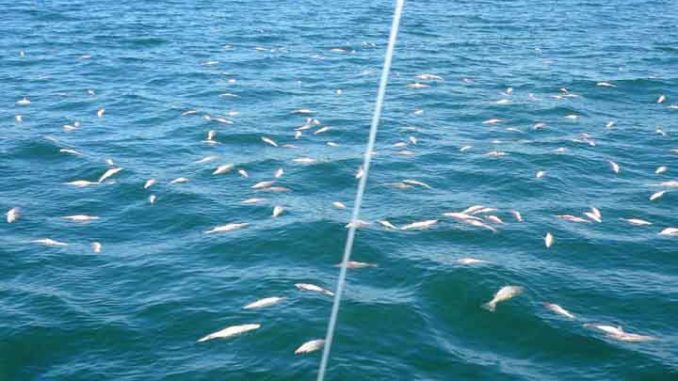
On Sunday, Jan. 16, commercial trawlers plied the waters off Oregon Inlet, setting nets to land striped bass.
Because of a long-standing N.C. Division of Marine regulation, commercial fishermen are allowed to keep 50 stripers per trip, but the rule doesn’t restrict the number of stripers a boat can land, so crews are allowed to discard smaller fish while working their way toward keeping the 50 largest.
That’s what four trawlers did Jan. 16 in the middle of an estimated 100 recreational boats, fishing near Kitty Hawk, Nags Head and Oregon Inlet south about six miles toward Rodanthe.
The ocean was littered with thousands of dead stripers that had been tossed overboard by deck hands on the trawler. The kill was so large that no one, including the N.C. Division of Marine Fisheries, has ventured a guess as to its size.
One recreational captain estimated that the single-day kill of culled stripers could likely equal the entire season’s catch by recreational fishermen, who are restricted to two fish of at least 28 inches in length per angler per day. The waste enraged anglers who witnessed it and the public, which has seen videos posted at YouTube. Two television stations in eastern North Carolina have broadcast news stories about the striper massacre.
“I’m not anti-commercial fishing, but the way the law is set up now allows them to throw back the smallest fish,” said Capt. Ches Tyson of the Carolina Blue. “I was out there Friday through Monday, and (commercial trawlers) were still hitting it hard, but the waste was nothing like it was on Saturday and Sunday.”
To view another photo or to leave a comment on the offshore fishing forum click here.
However, Tyson said he wasn’t surprised by the incident.
“What they did, they did last year and in years past,” he said. “Nobody spoke up much about it last year because there weren’t as many (recreational) boats to see it, and the stripers were mostly up north toward Virginia Beach. “But it’s not anything new. Obviously, a lot of money is involved.”
Capt. Jarvis Miller of the Reel Rebel also was fishing that day and saw the carnage.
“It was a pretty holiday weekend and lots of boats were out there,” he said. “A lot of people saw what’s been happening every year.”
Miller said the main problem occurred near Kill Devil Hills, directly offshore from the Wright Memorial.
“(The trawl boats) would get the fish, dump the smaller ones by culling them out, then re-set (their nets),” he said. “The ocean was full of legal (28-inch minimum size) fish, from 10 to 30 pounds. They are allowed to keep the 50 largest fish and throw the rest overboard.”
Miller said the nature of trawling is the major problem for striped bass.
“Depending on the length of the drag, the more fish are stacked onto one another in the (tail)bag,” he said. “The weight crushes them, and that means these stripers don’t have a chance to survive after they’re thrown overboard.
“Also, a lot of times before they get thrown over the side, (deck hands) cut their bellies (air bladders) so they’ll sink. But a lot of them don’t sink.”
Miller said gill netters often go behind trawl netters to wipe up stripers that escape the trawls.
“A lot of (local sport fishermen) are scared, and some don’t want to ruffle any feathers, but I can’t sit back and watch it anymore and not say something,” he said. “I’m not completely against commercial fishing, but this is wrong.”
Miller said some commercial fishermen aren’t happy with the unintended outcome of trawl netting, but they’re not breaking any rules. Still, they believe the 50-fish per boat regulation should be changed to a total-allowed-poundage per boat so potential discards would have to be kept instead of wasted.
“One of the commercial fishermen said that this is what’s gonna happen when you have a rule that allows it,” Miller said.
The N.C. Division of Marine Fisheries allows a 480,480-pound commercial quota for ocean-caught striped bass in waters three miles from the shore or closer for the 2010-11 season. DMF also allows a gill-net striped bass fishery to land 160,160 pounds of the larger quota.
The regulation that allows trawl netters to discard striped bass says: “It is unlawful for an Atlantic Ocean Striped Bass Commercial Gear Permit trawl holder to possess, land or sell more than 50 striped bass per vessel, per day, regardless of the number of permit holders on board, during the harvest period beginning at 12:01 a.m., Saturday, January 15, 2011 and ending at 6:00 p.m., Thursday, January 20, 2011.”




Be the first to comment